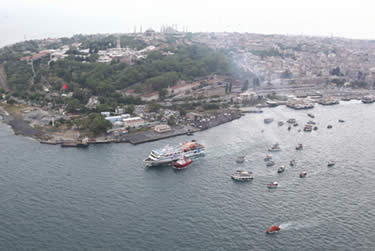Published: may 26, 2010; Intelligence and Terrorism Information Center.
On May 14 the Rachel Corrie set sail from the Irish port of Dundalk, the first ship of the aid flotilla for the Gaza Strip organized by a coalition of pro-Palestinian organizations in Europe and Turkey. On May 22 the passenger ship Mavi Marmaris set sail from the port of Sarayburnu (Seraglio Point) in Istanbul. It is the first of three Turkish ships planned for the flotilla (the other two are cargo ships). The plan is for all the participating ships to meet in Cyprus and from there to sail to the Gaza Strip. There will be at least nine ships, possibly more according to some reports.
As of this writing, the following is known:
A. Timetable: The ships are expected to meet off the coast of Cyprus and to reach the Gaza Strip on the morning of May 29 (the exact time is not yet known).
1) The Irish ship Rachel Corrie, which left Ireland on May 14 (Free Gaza website, May 22, 2010) has passed Portugal.
2) The first IHH Turkish ship, the Mavi Marmara, set sail from Istanbul on May 22. After 40 hours at sea it was expected to dock at the port in Antalya, where 500 passengers would get on board, and where it would be joined by two Turkish cargo ships. The three vessels will set said from Antalya on May 25 and should reach the Gaza Strip 24 hours later (IHH website, May 23, 2010).
3) Four ships, two Greek and two Cretan, are expected to set sail from Greece on May 24 or 25. Three are passenger ships and the fourth will carry cargo. According to one report, they have encountered problems, including strikes, government intervention and pressure exerted on the organizers (Al-Jazeera TV, May 22, 2010). According to another, a Greek-Swedish cargo ship set sail from Athens on May 24 with equipment and media personnel on board (Safa News Agency, May 24, 2010).
4) An Algerian ship carrying more than 4,000 tons of equipment set sail on May 22 en route to Istanbul to join the convoy. On board is a delegation of 22 people, among them ten members of the Algerian parliament representing various parties. There are also journalists and pro-Palestinian activists. The convoy coordinator in Algeria said that the passengers were determined to reach the Gaza Strip and that Israel’s threats did not scare them (Kuwaiti News Agency, May 22, 2010).
B. The ships and passenger lists: At least nine ships are expected to reach the Gaza Strip, carrying between 800 and 1,000 passengers from 40 countries. The Turkish ship is expected to carry 600 passengers (most of whom were supposed to board in Antalya). They include members of parliament, human rights activists and media personnel, etc. A group of Israeli Arabs was also expected to join, among them Muhammad Zaydan, head of the Israeli Arab Monitoring Committee, Sheikh Ra’ed Salah, head of the northern faction of the Islamic Movement, Hamad Abu Daa’bas, head of the southern faction of the Islamic Movement, and Israeli Parliament member Hanin Zoabi, from Balad, a nationalist Arab political party. Rami Abdo, a member of Hamas’ Popular Committee to Lift the Siege, said that some international activists had canceled their participation in the flotilla (Ma’an News Agency, May 20, 2010).
C. Media coverage:
1) According to reports, the places vacated by activists who canceled their participation will be taken by foreign correspondents and media correspondents in order to broaden coverage of the event. The media covering the event from the decks of the ships include Al-Jazeera TV, Reuters, BBC Radio, Euro News, representatives from Bulgarian and Czech TV and a large number of correspondents from international newspapers and news agencies (Ma’an News Agency, May 20, 2010).
2) Jamal al-Khudari, head of Hamas’ so-called “Popular Committee for the Struggle against the Siege” said that it planned to send 100 small Palestinian boats to receive the flotilla when it arrived off the coast of the Gaza Strip as part of the media pressure Hamas plans to exert on Israel. The boats will fly Palestinian flags and those of the countries participating in the flotilla, and their passengers will include the heads of the Committee, jurists and groups of observers. Some of the boats will be allocated to journalists, media representatives and photographers.
D. Diplomacy statements from important figures: The spokesman for the Irish Green Party, who also personally supervised loading the equipment in the port in Ireland, said that holders of Irish passports were to be treated fairly and allowed to complete their mission. He said it was the least Israel could do after it recently unfair use made of Irish passports. Breifne O’Reilly, the Irish ambassador to Israel, met with Israel’s foreign minister to receive Israeli assurance that it would allow the unloading of the equipment to proceed quietly and securely (Free Gaza website, May 21, 2010).
Preparations in the Gaza Strip and statements from Hamas activists: Osama al-Isawi, transportation minister in the de facto Hamas administration, said that the transportation ministry and the labor and housing ministry were making the necessary preparations to receive the ships. He said that his ministry was coordinating with all the others. Yussef al-Munsi, public works minister, said that intensive work was being carried out to deepen the port (Hamas’ Palestine-info website, May 17, 2010).
Hamas activists made various statements regarding the flotilla and Israel’s expected objection to it:
A. Ahmed Yussef, who was appointed head of the “Government Committee to List the Siege and Receive the Delegations,” has often been interviewed by the media. According to his claims, the flotilla is legal and that any Israeli attack on it would be a violation of international law. He said Israel would continue to threaten the flotilla but would not prevent it from reaching the Gaza Strip because such a step would have [a negative] influence on its security and strategic relations with Turkey. He added that the flotilla had purchased two ships which could transport money, aid and building materials to the Gaza Strip (Al-Aqsa TV, May 22, 2010). In another interview he said that the flotilla would cause an international storm and that it would receive wide media and political coverage. He said that it would clearly show that Israel was imposing collective punishment on the residents of the Gaza Strip (Hamas’ daily Felesteen, May 16, 2010).
B. Hamas spokesman Sami Abu Zuhri said that Israel’s stated intention of attacking the flotilla was “thuggism.” He called on the organizers to carry out the mission as planned without taking its consequences into consideration. He said it was a historic event which would “expose Israel’s crimes against the Gazans.” He also said that it would reflect the fact that the Gaza Strip had become a “Mecca for various activists because of its firm stance and courage” (Hamas’ Palestine-info website, May 19, 2010).
C. Jamal al-Khudari, head of the Popular Committee to Lift the Siege, said that the ships were a problem for Israel, which was debating what to do about them. He said that preventing them from reaching their goal would be “piracy and a violation of international law” (Da’wah website, May 18, 2010).
The Turkish Aspect: Launching the Flotilla from Turkey and Statements from IHH Activists
The departure of the Turkish ship was accompanied by a well-attended rally in the Istanbul port. Thousands of people came, among them senior Turkish political figures. Sheikh Ra’ed Salah, chairman of the northern faction of the Islamic Movement in Israel was also in attendance. Speeches were given by members of various organizations and money was contributed for the flotilla.
Bülent Yildirim, IHH chairman, the moving spirit behind the flotilla, gave a fiery speech praising those who had come to the rally, saying, “We are determined to go, and will not retreat.” He added that “Israel is acting the way Hitler acted toward the Jews. Hitler built concentration camps in Germany, today Zionism builds concentration camps in Palestine.” To Israel he said, “Handle this crisis well. If you prevent [the flotilla from reaching the Gaza Strip] you will remain isolated in the world and harm yourselves.” Sheikh Ra’ed Salah gave a speech praising the position taken by the Turkish prime minister and the country’s firm stance. He said all the leaders of the Western world should behave like him (IHH website in Turkish, May 23, 2010).
According to ITIC information, the ceremony in Istanbul was also attended by radical Islamic figures affiliated with the Muslim Brotherhood who participated in the previous aid convoys. Also in attendance were Muhammad Kazem Sawalha and Zaher Khaled Hassan al-Birawi, both former Hamas activists who today reside and are active in Britain, and Hamam Sayid, Muslim Brotherhood leader in Jordan.
On May 12, Muhammad Kaya, head of the IHH branch in the Gaza Strip, said there was a plan to send monthly flotillas to the Gaza Strip to show the Gazans’ suffering to the world (Al-Jazeera-Info website, May 21, 2010).
The Egyptian Aspect
The director of the port at El-Arish, Gamal Abdel Maqsoud, said that preparations were being made at the port to receive the nine ships should Israel refuse to allow them to reach the Gaza Strip. He said that the reception depended on getting approval from Egyptian security and diplomatic factors, and coordination between the flotilla’s organizers and senior Egyptian figures, a situation which did not currently exist. Should such a situation occur, the cargo could be unloaded and sent overland to the Gaza Strip through the Rafah crossing. He added that if the ships were too large for the harbor at El-Arish, the cargo could be unloaded to smaller boats in order to bring it ashore (Interview in Al-Yawm Al-Saba’a, May 23, 2010).
“Egyptian diplomatic sources” confirmed the deliberations in the Egyptian foreign ministry about the ships, but said that Egypt had not yet made a decision about allowing the convoy into Egypt. They also said that should Israel prevent the aid flotilla from entering the Gaza Strip by sea, Egypt might delay their entrance into its territory because no previous coordination with the Egyptians had been conducted effected (Hamas’ Palestine-info website, May 23, 2010).



 RSS
RSS











The Aid Flotilla for the Gaza Strip #israel #islamism #islam #jcot http://j.mp/c4Lnbq
RT @CrethiPlethi: The Aid Flotilla for the Gaza Strip #israel #islamism #islam #jcot http://j.mp/c4Lnbq
[…] This post was mentioned on Twitter by Elisabeth, Crethi Plethi. Crethi Plethi said: The Aid Flotilla for the Gaza Strip #israel #islamism #islam #jcot http://j.mp/c4Lnbq […]
[…] A. Ahmed Yussef, who was appointed head of the “Government Committee to List the Siege and Receive the Delegations,” has often been interviewed by the media . According to his claims, the flotilla is legal and that any Israeli attack on it would be a … Go here to read the rest: The Aid Flotilla for the Gaza Strip | Middle East Affairs … […]